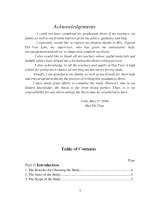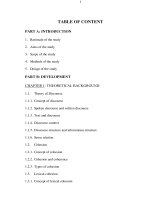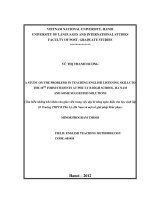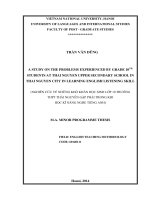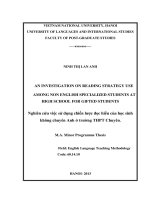Problems in learning english listening skill at high school and suggested solutions = những vấn đề trong việc học kĩ năng nghe tiếng anh ở trường phổ thông và các giải pháp gợi ý
Bạn đang xem bản rút gọn của tài liệu. Xem và tải ngay bản đầy đủ của tài liệu tại đây (334.06 KB, 48 trang )
vinh university
foreign languages department
----------
phạm thị thu mai
problems in learning English
listening skill at high school and
suggested solutions
(Những vấn đề trong việc học kĩ nÃng nghe tiếng Anh
ở trờng phổ thông và các giải pháp gợi ý)
graduation thesis
field: methodology
Vinh, 2009
Acknowledgements
My graduation thesis has been completed with a lot of encouragement and
support from my teachers, friends and family.
First of all, I would like to express my deep grate to my supervisor, Mrs
Nguyen Thi Van Lam, M.A for her indispensable and useful advice,
suggestions and support. But for her, this graduation thesis would not have
been completed.
In addition, I want to give my sincere thanks to the Dean and the teachers in
the Foreign Language Department for their precious support and
encouragement.
I also cannot forget the support of the students from Nguyen Xuan On high
school. Without them, I could not have carried out the survey.
Lastly, I wish to thank my family and my good friends who have been very
helpful and encouraged me during doing this graduation thesis.
Vinh May 10th 2009.
Pham Thi Thu Mai
Vinh University
2
TABLE OF CONTENT
ACKNOWLEDGEMENT…………………………………………………...1
TABLE OF CONTENT……………………………………………………...2
LIST OF FIGURES………………………………………………………….5
PART 1: INTRODUCTION.....................................................................6
1. Reasons for Choosing the Topic...............................................................6
2. Aims of the Study.....................................................................................7
3. Scope of the Study.....................................................................................7
4. Methods of the Study................................................................................7
5. Design of the Study....................................................................................8
PART 2: DEVELOPMENT.........................................................................9
Chapter 1: Theoretical Background....................................9
1.1.
What is Listening Skill?......................................................................9
1.1.1. Definition of Listening Skill................................................................9
1.12. Importance of Listening Skill..............................................................9
1.1.3. Types of Listening..............................................................................10
1.2. Communicative Language Teaching (CLT).......................................11
1.2.1. Characteristics of CLT........................................................................11
1.2.2. Teacher Roles in CLT........................................................................11
1.2.3. Student Roles in CLT.........................................................................12
1.3. Teaching English Listening in CLT...................................................13
1.3.1. Principles of Teaching English Listening Skill.................................13
1.3.2. Subskills in Listening........................................................................15
1.3.3. Types of Listening Activities............................................................17
1.3.3.1. No Overt Responses.........................................................................17
1.3.3.2. Short Responses................................................................................17
1.3.3.3. Longer Responses............................................................................18
1.3.3.4. Extended Responses.........................................................................18
1.4.
Summary...........................................................................................18
CHAPTER 2: REAL SITUATION OF LEARING LISTENING SKILL AT
NGUYEN XUAN ON HIGH SCHOOL.......................................................19
2.1. Overall View about Real Situations of Teaching and Learning
English Listening at Vietnamese High Schools........................................19
2.1.1. Some Comments on Listening Exercises and Activities in High School
Textbooks......................................................................................................19
Vinh University
3
2.1.2. Difficulties in Teaching and Learning English Listening...................20
2.1.3. Real Situation of Learning and Teaching English Listening at Nguyen
Xuan On high school.....................................................................................21
2.2. Main Reasons for the Difficulties in Learning Listening Skill.....22
2.2.1. Subjective Reasons.............................................................................22
2.2.2. Objective Reasons..............................................................................23
2.3. Survey on Learning English Listening Skill at Nguyen Xuan On
high school....................................................................................................24
2.3.1. Aims of the Survey.............................................................................24
2.3.2. Description of the Survey...................................................................24
2.3.3. Results of the Survey..........................................................................25
2.4. Summary...........................................................................................35
CHAPTER 3: Suggested Activities to Improve Learning
Listening Skill at High School...................................................37
3.1. Introduction..........................................................................................37
3.2. Suggested Solutions..............................................................................37
3.3. Some Suggested Kinds of Listening Exercises to Motivate Students
into Listening...............................................................................................39
3.3.1.Chain Game- Retelling a Short Story...................................................39
3.3.2. Drawings.............................................................................................41
3.3.3. Cross-words.........................................................................................41
3.3.4. Lucky Listening Topics.......................................................................43
3.3.5. Guessing the Content of the Lesson....................................................44
3.3.6. Rearranging the Order of the Conversation.........................................45
3.3.7. Choosing the Right Topics..................................................................45
3.3.8. Making T/F Statements.......................................................................46
3.3.9. Listening to Short English Songs.........................................................47
3.4. Summary............................................................................................47
PART 3: CONCLUSION.........................................................................48
3.1. Recapitulation.......................................................................................48
3.2. Suggestions for Further Study............................................................49
REFERENCES..............................................................................................50
APPENDIX...................................................................................................52
Vinh University
4
Vinh University
5
LISTS OF FIGURES
Figure 2.1. Students’ Interest in Learning English ………………………...25
Figure2.2. Students’ Opinions about Degrees of Difficulty of Listening
Skill…………………………………………………………………………26
Figure 2.3. Factors Affecting Students’ Listening…………………….........26
Figure 2.4. Students’ Amount of Time for Practicing Listening Skill……...27
Figure 2.5. Students’ Frequency of the Guessing Habit……………………28
Figure 2.6. Students’ Ways of Listening………………………..………….28
Figure 2.7. Students’ Frequency of Distraction…………………………….29
Figure 2.8. Students’ Times of Listening per Lesson…………………........30
Figure 2.9. Influence of Listening Equipments on Students’ Listening…....31
Figure 2.10. Students’ Opinions about Listening Topics and Exercises…...32
Figure 2.11. Students’ Favorite Types of Listening Exercises……………..33
Figure 2.12. Students’ Opinions about Extra Listening Activities……........34
Figure 2.13. Motivating Factors…………………………………………....35
Vinh University
6
Part 1:
INTRODUCTION
1. Reasons for Choosing the Topic
English Teaching Methodology is a very important subject for everyone
who wants to become teachers of English. In this subject, students of English
who are being trained to become teachers will be provided with necessary
information about techniques and methods of teaching four language skills:
listening, speaking, reading and writing. Of all these four skills, listening skill
is considered to be one of the most difficult skills to teach and to learn. As
students of English, the author herself and others have met a lot of difficulties
in learning this skill. She has chosen the topic about “Problems in LearningProblems in Learning
English Listening Skill at High School and Suggested Solutions ” for
several reasons.
Firstly, listening skill is thought to be the most difficult in teaching and
learning a language in general and English in particular. A lot of teachers and
students meet many problems and difficulties in teaching and learning this
skill. Therefore, the author studies this topic to point out the main problems
and difficulties which teachers and students have met and then can find out
the important reasons for these matters.
Secondly, listening skill plays a very important role in teaching and
learning a language so it should be paid much more attention to. However, it
seems that this skill is not really focused on in many high schools in Vietnam
and the qualities of teaching and learning this skill are not very good. Thus,
this topic is chosen to study in order to find out some suggested solutions to
partly improve this matter.
Moreover, although learning English listening skill is significant, the fact is
that not many students like learning this skill for many reasons such as the
difficulty in learning it well or listening lessons are quite boring. Thus, the
purpose of studying this topic is to create some new and interesting listening
activities to motivate students into listening skill.
2. Aims of the Study
The study is conducted with the following aims: because teaching listening
skill is one of the most difficult tasks for any ESL teacher, the first aim is to
find out the problems and difficulties in learning and teaching English
listening skill at high school. Additionally, the study is carried out so as to get
more information about the qualities of teaching and learning English
Vinh University
7
listening skill at Vietnamese high schools. It is also necessary to find out the
main reasons for these problems and difficulties. Last but not least, the study
suggests some solutions to these problems to partly improve the qualities of
teaching listening skill and motivate students into listening lessons.
3. Scope of the Study
The topic about “Problems in LearningProblems in Learning English Listening Skill at High
School and Suggested Solutions” is a broad topic and it cannot be exploited in
the study due to the limitation of a B.A thesis. Therefore, the study only
focuses on the main problems which cause difficulties for both teachers and
students and the real situations of teaching and learning English listening skill
according to a survey done in three grades of a high school. Besides, from this
survey, some suggestions and solutions are given in order to partly improve
the quality of teaching and learning English listening skill at high school.
4. Methods of the Study
Due to the scope and the characteristics of the study, the author follows
the procedures:
Collecting and analyzing the materials
Synthesizing the information
First, some materials referring to the issue are collected and analyzed
Then, basing on the theoretical background described and analyzed, the
survey will be carried out. Next, the information from the survey will be
analyzed in detail and the results will be categorized to synthesize. From the
results collected, it will come to the general conclusion and some comments
and solutions will be given.
5. Design of the Study
The thesis consists of three main parts: the first part is Introduction. This
part provides the information about the reasons for choosing the topic, the
aims of the topic, the scope of the study, the method of the study and the
design of the study. In the second part – Development, there are three
chapters. Chapter 1- Theoretical background discusses some main points
relating to the topic: definition of listening skill and its importance, CLT with
teachers’ roles and students’ roles, the main principles of teaching listening
and the main kinds of listening activities. This chapter focuses on the theory
about the main types of listening activities and teaching it in CLT. Chapter 2 The real situation of learning English listening skill at Nguyen Xuan On high
school describes the whole picture about the real situation of learning English
Vinh University
8
listening skill of the students in this school through the survey done in three
grades. In chapter 3 - Suggested activities to improve learning listening skill at
high school, some solutions to the problems students have when learning
listening are suggested and some listening activities are recommended to be
applied in teaching and learning this skill with the aim to motivating students
into learning this skill. The last part is Conclusion. This part summarizes the
main points discussed in the previous parts and offers some suggestions for
further study. The study ends up with references which are the materials
collected to find necessary information for the study and appendix which is
the questionnaire used in the survey.
Vinh University
9
Part 2: DEVELOPMENT
Chapter 1: Theoretical Background
1.1. What is Listening Skill?
1.1.1. Definition of Listening Skill
Listening skill can be defined in different ways. According to MC Milan
Dictionary, listening is to pay attention to a sound or to try to hear a sound or
to pay attention to what someone tells you and do what they suggest. Babylon
Dictionary views listening as an attempt to hear something, an act of paying
careful attention to one who is speaking. Similarly, in the New Era EnglishEnglish-Vietnamese Dictionary, listening is to make an effort to hear
somebody or something.
Thus, listening is the language modality that is used most frequently.
Listening involves a sender (a person, radio, and television), a message, and a
receiver (the listener). Listeners often must process messages as they come,
even if they are still processing what they have just heard, without
backtracking or looking ahead. In addition, listeners must cope with the
sender's choice of vocabulary, structure, and rate of delivery. The complexity
of the listening process is magnified in second language contexts, where the
receiver also has incomplete control of the language. Listening skill is
integrated with the other skills in language use. Like reading, listening is a
receptive skill where the purpose is to comprehend or understand what
someone might be saying or writing.
1.12. Importance of Listening Skill
In daily life, people spend a lot of time listening: officers listen to their
boss’ talks, students listen to their teachers, old people listen to news on TV
and radio. It has been estimated that adults spend almost half of their
communication time listening.
In language use, listening skill plays a very important role: it includes
various kinds of listener’s knowledge: knowledge of phonology, vocabulary,
semantics of the language in use, culture of its people, his life experience in
the topic, his ability to predict and respond. It decides his comprehension,
content and attitudes in response to the speaker’s speech as well. Therefore, if
we are bad at listening, we will fail to communicate with others. In addition,
there is a very close relationship between listening and speaking skills: in
learning English as a foreign language, students cannot develop speaking skill
unless they develop listening skill. To have a successful conversation, they
Vinh University
10
must understand what is said to them. Moreover, it is vital for them to be able
to understand native speakers in order to develop their study and communicate
more successfully. Listening is an important way of acquiring the language or
learning new vocabulary and structures.
1.1.3. Types of Listening
In real life, there are two main kinds of listening (Nguyen Thi Van Lam
and Ngo Dinh Phuong, 2007): The first kind is casual listening: we listen to
something without any particular purposes in our mind and we often do not
concentrate on it much to get the information. Usually, we hear it by chance.
Therefore, we rarely can remember much of its content. This way is often
used in entertaining activities. For example, we listen to a song while doing
the house work or talking to someone. The second kind is focused listening
which is quite different from the first one: we listen to something with some
particular purpose in mind and pay much attention to it so as to get as much
information as possible. However, we do not listen to everything with equal
concentration: we only focus on the important information for some purposes.
For example, students listen to an English text to do the tasks given by the
teacher or a customer listens to the instructions of the seller to use a computer.
In language learning, students usually use the second way of listening and
casual listening is sometimes used for extra and further practice such as
letting students listen to a song or a short story without any response required.
1.2. Communicative Language Teaching (CLT)
1.2.1. Characteristics of CLT
CLT is one of the most popularly used approaches in language teaching.
The origins of CLT are to be found in the changes in the British language
teaching tradition dating from the late 1960s. CLT has been used in language
teaching with two aims: make communicative competence the goal of
language teaching and develop procedures for the teaching of the four
language skills. At the level of language theory, CLT has a rich, eclectic and
theoretical base. Some of the characteristics of this communicative view of
language are: language is a system for the expression of meaning, the primary
function of language is for interaction and communication and the structure of
language reflects its functional and communicative uses (cited in Nguyen Thi
Van Lam and Ngo Dinh Phuong, 2007). Nowadays, this approach has been
widely used in many language schools in the world for its advantages such as:
Vinh University
11
it focuses on developing communicative competence of learners and reflects
their needs including functional skills and linguistic objectives.
1.2.2. Teacher Roles in CLT
In language teaching and learning, teachers play a predominant role
because of students’ ages, character, psychology and lack of English
knowledge. Several roles are assumed for teachers in CLT, the importance of
particular roles being determined by the view of CLT adopted. According to
Breen and Candlin (cited in Nguyen Thi Van Lam and Ngo Dinh Phuong,
2006), the teacher has two main roles: the first is to facilitate the
communication process between all participants in the classroom and between
these participants, the various activities and texts. The second role is to act as
an independent participant within the teaching-learning group. Additionally,
teachers can act as researcher and learner, with much contribution in terms of
appropriate knowledge and abilities, actual and observed experience of the
nature of learning and organizational capacities.
Other roles assumed for teachers are needed analyst, counselor, and group
process manager. The CLT teacher assumes activities which are responsible
for determining and responding to learner language needs. In the role as a
counselor, the teacher is expected to exemplify an effective communicator
seeking to maximize the meshing of speaker intention and hearer
interpretation, through the use of paraphrasing, confirmation and feedback.
Moreover, CLT procedures often require teachers to acquire less teacher –
centered classroom management skills. It is the teacher’s responsibility to
organize the classroom as a setting for communication and communicative
activities.
All in all, teachers really play multiple roles in English language teaching:
They are knowledge conveyers - supplying students language knowledge and
skills, they are helpful helpers, helping students get English information and
analyze it, helping students to learn, and solve problems. Moreover, they are
companions- staying by students’ side; they are organizers-organizing
activities for students, and they are controllers, making sure students are
disciplined in the classroom.
1.2.3. Student Roles in CLT
Students play a role as the main body in language teaching and learning.
Furthermore, the emphasis in CLT on the processes of communication rather
than mastery of language forms - these lead to different roles for learners from
Vinh University
12
those found in more traditional second language classrooms. Breen and
Candlin (cited in Nguyen Thi Van Lam and Ngo Dinh Phuong, 2006) describe
learner roles as negotiators - between the self, the learning process, and the
object of learning - emerges from and interacts with the role of joint
negotiator within the group and within the classrooms procedures and
activities which the group undertakes. The implication for the learner is that
he should contribute as much as he gains, and thereby learn in an independent
way.
Thus, learners have the roles as negotiators, interactors, communicators
and responsible managers of their own learning. It is quite different from the
traditional method of learning; students nowadays are taught to learn on their
own and learn to use knowledge to communicate with others well. These are
the important aims of teachers who use CLT to teach.
1.3. Teaching English Listening in CLT
1.3.1. Principles of Teaching English Listening Skill
To teach any skill of a language, it is important for teachers to follow the
principles for teaching that skill so as to teach it more effectively and
methodically. Forseth (cited in Nguyen Thi Van Lam and Ngo Dinh Phuong,
2007) suggests seven principles for teaching listening skill:
First, the teacher should use authentic texts and present them as naturally
and realistically as possible. Authentic texts can be taken from various radio
broadcasts or interviews such as VOA and BBC. These texts are very useful
and necessary because they allow background noise or interruptions and
contain different types of voices and accents and natural conversations. These
will help students get used to listening to daily life conversations of native
speakers.
Second, it is better to include different kinds of texts: conversations,
dialogues, jokes, lectures, news broadcasts…For these kinds of texts, students
can get used to listening to different pieces of speech and it helps avoid
boredom caused by listening to the same topic or the similar type of listening
texts many times.
Third, the teacher should use primarily meaning- based tasks for students to
do. This is an example of a meaning- based task: Circle the definition for the
word you hear:
a. It is a pet that likes eating mice (cat)
b. It is an animal that can fly
(bat)
Vinh University
13
Students will have to listen very carefully and pay attention to their meanings
to distinguish two words correctly because they are a minimal pair so they
may confuse hearers. These activities help them focus more on the meaning of
the listening text.
The fourth principle is that the teacher states a specific purpose for the
listening task. It is necessary that students be given a purpose for listening to a
text or they may not know what they should focus when listening and then
miss important information. In addition, being given the purpose beforehand,
students will be motivated into the lesson more.
Another principle is that the teacher introduces the listening task
beforehand. Be sure to prepare for them what they will hear. This can be done
in many ways such as asking questions relating to the topic they will listen to
or asking them to talk about their own experience relating to the main topic so
that students can think of the listening topic more carefully.
The next principle is to avoid pre-teaching vocabulary unless necessary.
This helps students get used to guessing the meaning of the new words from
the context. Besides, students should have the habit of understanding the
meaning of a text without trying to know the meanings of all the words as this
can make their listening lessons more difficult and stressful. The only words
that should be pre-taught are those necessary for understanding the main idea
of the text.
Lastly, the teacher should let students listen to the text more than once.
Moreover, after each time of listening, students should be allowed some time
to check their answers. In fact, it is very difficult for students to be able to
understand the text after the first time of listening. If the text is repeated,
students will have more chances to fill the missing information and
understand the text fully.
1.3.2. Subskills in Listening
Like the other skills, listening includes a number of different sub-skills
(Nguyen Thi Van Lam and Ngo Dinh Phuong, 2007): learners have to
recognize differences between phonological sounds - the difference in a single
sound makes a new word with a different meaning. These pairs of words are very
difficult to distinguish so they can cause confusion and misunderstanding. Thus, it
is necessary to distinguish them correctly. For example, the minimal pair bull
and pull contain two sounds /p/ and /b/ which make these two words different
in terms of meanings. Another subskill of listening is comprehension of
Vinh University
14
structures: For example, in the sentence “Problems in Learninghave you ever seen a fish walk?” , the
listener must understand that “Problems in Learningseen” is a verb and “Problems in Learningfish” is a noun and this
must be a question. In addition, learners may guess the unknown words or
recognize words which are unnecessary for understanding. Like reading skill,
when listening to a text, it is not necessary to understand the meanings of all
the words. Therefore, for some unimportant words, students can guess their
meanings or even ignore them. This helps them concentrate on catching the
key words of the text. There are also some other subskills such as recognizing
discourse markers and cohesive words which help hold discourse together, the
ability to infer information that is learners by hiding the direct answers and
learners have to search for the indirect answers carefully. To do this kind of
exercises, learners are required to understand the listening text wholly. For
example, from the sentence “Problems in LearningToday is Thursday and I will go to Ho Chi Minh
in two days” , the listener must infer that the speaker will go to Ho Chi Minh
on Saturday. Furthermore, skimming is a sub-skill for which listeners do not
need to understand every word they hear but they only need to catch the main
idea because if they try to focus on listening all words, they will miss the
important information. This is very helpful when they listen to news on radio
or TV. By contrast, for scanning skill, listeners have to look for the specific
information. This skill is often used to do certain listening tasks such as
answering questions or choosing the best answer (multiple choices). For the
summarizing skill, listeners should summarize what they have heard after
listening or they have to decide what they are listening to is true or false or
they agree with what they are listening or not- this is called critical listening
and especially used for advanced learners. Rather than only understand the
message or the main ideas of the text, they have to make judgments of its.
Recognizing different styles, emotional tones and varieties of language is a
quite challenging skill. It is very interesting to listen to different styles such as
formal and informal, emotional tones such as anger, happiness and varieties of
language such as British English, American English…but these are also very
difficult to recognize particularly varieties of language. Two more sub-skills
of listening are predicting what a speaker will say next - this helps the hearer
respond more quickly and makes the conversation more cohesive and listening
for total comprehension: The listener has to understand every thing the
speaker says. This skill is used for a special purpose. For example, a patient
Vinh University
15
has to listen to all the constructions the doctor says to drink the medicine
correctly.
1.3.3. Types of Listening Activities
There are four main types of listening activities mentioned in Nguyen Thi
Van Lam and Ngo Dinh Phuong (2007)
1.3.3.1. No Overt Responses
Students have to do nothing in response to the listening but teachers can
check their understanding by their body language and expressions. For this
type, teachers can use some different activities. For example, teachers may tell
a story or play a recording of the story and students will be motivated to
attend and understand in order to enjoy it or teachers let students listen to
songs: teachers may sing a song themselves or play a recording of the song.
Another no overt response activity teachers can use is that they may let
students see an interesting film and students will be motivated into trying to
understand it. These activities are usually very interesting and can attract
students’ attention easily. However, teachers have to make sure that students
pay attention to the content of the story, the song or the film and they should
not only enjoy them without understanding any words.
1.3.3.2. Short Responses
For this kind, students have to do various listening activities. For example,
they are asked to perform actions or draw shapes or pictures in response to the
teacher’s instructions, tick off words while hearing them from the text within
a list of items given beforehand, or a number of statements are given after
listening and students are asked to point out which ones are true and which
ones are false. Also, there are some other activities such as detecting mistakes:
the teacher may tell a story about something that students have known and this
contains some mistakes and students have to point out these mistakes when
listening to it, filling the missing information in the gaps, guessing
definitions: the teacher gives students some definitions of something and
students have to point out what it is, skimming and scanning: a listening text
is given and students are asked to look for the main content of the text or its
specific information.
1.3.3.3. Longer Responses
The listening activities for longer responses are often much more difficult
than the short ones. Students have to do the tasks such as answering questions,
taking notes-this is a quite difficult response- students are asked to write down
Vinh University
16
the main points of a listening text, paraphrasing a listening text after listening
with their own words or translating it into another language, summarizing the
listening text and filling in the long gap-a long gap is left and students have to
find the missing information to fill in the gap.
1.3.3.4. Extended Responses
These responses are called “Problems in Learningcombined skill” activities as they involve many
skills at the same time. Some of these responses are: Problem-solving: for this
activity, students are asked to discuss a problem which has been orally
described how to deal with it or to solve it and Interpretation: in this activity,
an extract from a piece of dialogue or monologue is provided with no previous
information. Listeners try to guess from the words, kinds of voices and other
evidence what is going on. These activities are suitable for advanced students
because they can practice and develop many skills together.
1.4. Summary
In short, this chapter deals with some main points relating to the topic
about listening skill. In the first place, it presents some definitions of listening
skill according to some dictionaries, its importance and two main types of
listening-casual listening and focused listening. The next main point presented
in the chapter is a popular approach for language teaching called
Communicative Language Teaching ( CLT ) with its characteristics, teachers’
roles and learners’ roles. At last, the chapter comes up with teaching English
listening in CLT. This part includes seven principles of teaching English
listening skill, twelve sub-listening skills and four main types of listening
skills which are no overt responses, short responses, longer responses and
extended responses.
Vinh University
17
CHAPTER 2: REAL SITUATION OF LEARNING LISTENING
SKILL AT NGUYEN XUAN ON HIGH SCHOOL
2.1. Overall View about Real Situations of Teaching and Learning
English Listening in Vietnamese High Schools
2.1.1. Some Comments on Listening Exercises and Activities in High
School Textbooks
Three textbooks of three grades in high school contain many different
types of listening exercises and the followings are the main kinds of listening
exercises selected from those textbooks: The first kind is T/F statements. This
is one of the most frequently-used kinds of listening exercises in the textbooks
of three forms. The number of T/F statements is often from 5 to 6 ones. The
requirement in most of these exercises is not too difficult: students only have
to decide whether the statement is true or false and they do not have to correct
the false information. For this kind of listening exercises, students can do the
exercise more easily but sometimes their answers cannot show their
understanding as they can guess the answers without understanding the
listening text. The next type is comprehension questions: like T/F exercises,
comprehension question exercises are also used in many listening lessons in
these textbooks. The number of questions is about five to six ones. These
questions are used for more specific information. In fact, the questions are not
too difficult for students to answer but they need to understand the specific
information of the text. This kind of exercises both requires much
concentration of students and helps them pay more attention to the detail of
the text. It also can check students’ understanding more exactly. Multiplechoice exercises are much used in many lessons of different language skills
Vinh University
18
especially in reading comprehension skill. They are also often used in many
listening lessons of these textbooks particularly in 11th and 12th form
textbooks. These exercises are very useful for students to distinguish the
different information but they cannot check students’ understanding exactly
because they can guess the answers with no need to understand the text.
Another type is gap-filling exercises: this kind of exercises is very much used
in many listening lessons. The passages or sentences with missing information
in the textbooks are not too long but some of them are quite difficult. These
exercises are very useful as they can check students’ understanding and help
them follow the content of the listening text better. But for the low level of
listening skill of high school students, it will be better if the missing
information does not contain too many words.
Those are the most frequently-used exercises in the textbooks of three
grades. However, it is thought that there should be more types of exercises so
as to avoid boredom and evoke students’ interest in learning more.
2.1.2. Difficulties in Teaching and Learning English Listening
It cannot be denied that listening equipments such as listening tapes,
cassette players play a very important role in learning listening skill.
Therefore, good and modern listening equipments are vital for teaching and
learning listening. However, there are not many high schools in VietNam
which can meet this requirement: even some schools do not have normal
listening equipments such as cassette players and the teachers have to read the
text themselves. Additionally, using cassette players is not a good way of
teaching listening and this can make the listening text more difficult to hear to
students because the volume of the cassette players may not be loud or good
enough for students to hear or the noise outside classroom may affect their
listening. But most of Vietnamese high schools use cassette players as main
listening equipments.
Moreover, for many university students, listening is the most difficult
skill to learn and they often get stressed or bored when they cannot understand
any thing in the listening text. This situation is even worse for high school
students. The followings are the popular problems they often meet when
listening: The first challenging difficulty is linking sounds. Native speakers
always use linking sounds when speaking and it is very difficult for foreign
students to distinguish these sounds: they may think it is a new word and try
to guess its meaning. Fast, natural native speech is also a hard problem to
Vinh University
19
solve. Most of native speeches are too fast for students to follow.
Consequently, they may miss much important information. In fact, it is easier
for them to listen to a foreign speech than a native speech. Furthermore, the
fact is that they need to hear a listening text more than once. Because they
cannot understand fast natural speech at the first time of hearing, they usually
have to listen to it again and again. They even have to spend most of the time
listening to a short passage but they still cannot catch the main idea. As a
result, they get bored or disappointed and this can affect their interest in
listening next time. It is that many students are very bad at focusing on the
key words or catching the main idea of the listening text. This problem is
rather popular. Perhaps, they are able to hear what the speakers are speaking
or understand many words in the text but they cannot catch the main content
of its. Another difficulty is that some students cannot concentrate on the
listening task. While listening, they often think of the other things or they let
their mind wonder somewhere outside the classroom. Even though they try to
focus on listening, they are still distracted from it.
2.1.3. Real Situation of Learning and Teaching English Listening at
Nguyen Xuan On high school
Nguyen Xuan On high school is a rather famous school in Nghe An
province. It was founded in 1946. It is well-equipped with a lot of modern
equipments: four labs with projectors, one lab for studying biology, one lab
for studying physics and many cassette players for learning English. In
addition, it has a room with a lot of computers for teaching and learning
informatics. This school is really a good teaching and learning environment
for teachers and students. During two months of teaching practice in this
school, it was realized that the teachers and students have made much effort to
enhance the quality of teaching and learning English. However, there are still
some problems such as: the modern teaching and learning equipments have
not been used very effectively, some teachers do not have really creative
methods of teaching so they cannot attract their students to learning.
Moreover, the number of students in this school who are good at English is
not high. Many of them do not pay much attention to learning English. There
are only a few of them in some classes such as 12B, 10C10, 11C10 who can
learn English well while a lot of other students have difficulty in learning this
subject. Therefore, they meet many difficulties in learning the skills especially
listening skill. According to them, this is the most difficult skill of all. A large
Vinh University
20

